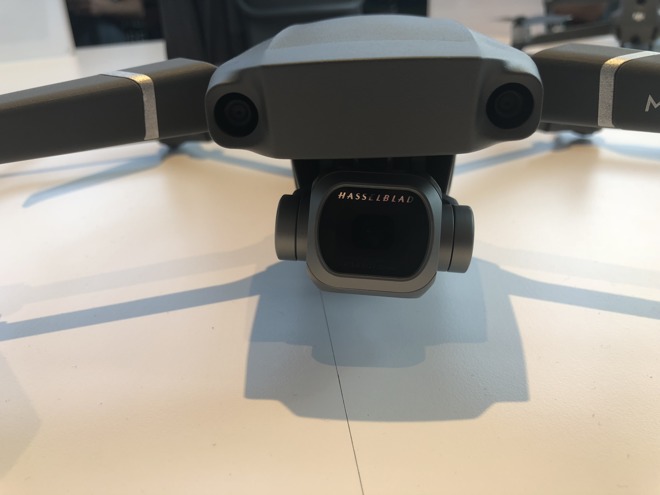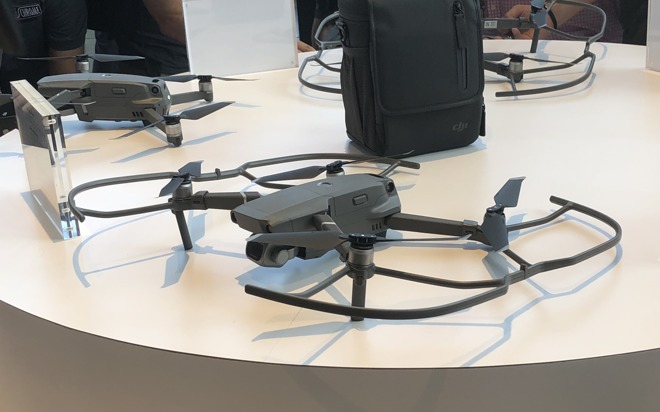DJI has launched a pair of drones in its Mavic range, with the Mavic 2 Pro the first to include an integrated Hasselblad camera, while the Mavic 2 Zoom is said to be the first foldable consumer drone with optical zoom capabilities.
Launched on Thursday, the Mavic 2 Pro's Hasselblad camera is claimed to provide outstanding image quality with superior light and color performance. Using a one-inch CMOS sensor with 10-bit Dlog-M color profile, the Mavic 2 Pro's camera can capture four times as many levels of color per channel compared to the original Mavic Pro.
Capable of capturing 20-megapixel aerial shots with the Hasselblad Natural Color Solution (HNCS) technology for high color accuracy, as well as 4K 10-bit HDR support for video, the lens offers apertures from f/2.8 to f/11, providing more control over a wide spectrum of lighting conditions.

The Mavic 2 Zoom opts for a 1/2.3-inch CMOS sensor, but packs in the ability to zoom, allowing for more creative shots while in motion. Combining a 24-48mm two-times optical zoom with a two-times digital zoom, the lens is capable of simulate a 96mm telephoto lens, said to provide lossless video in full HD resolution.
The Zoom also includes a hybrid auto-focus combining phase and contrast detection, increasing focus accuracy and making focus speed 40 percent faster than previous models. Able to shoot 12-megapixel photos, the Zoom has a Super Resolution feature that uses the optical zoom to automatically capture and stitch nine photographs together into a single 48-megapixel image.
One exclusive feature of the Mavic 2 Zoom is a new Dolly Zoom Quickshot that can recreate an effect used by cinematographers, where the camera moves away and zooms in at the same time.

Both models are able to capture 4K video at a 100-megabit bitrate using the H.265 codec. For photographers, the Enhanced High Dynamic Range capabilities combines a sequence of photos for ghost-free dynamic range, with the Pro and Zoom offering 14 and 13 stops of dynamic range respectively.
Both also include intelligent tools for motion and tracking, including various flight modes for different types of shots, including free flight, Circle for flying around a single point, Course Lock for shooting a subject while the drone flies forward, and Waypoint navigation. ActiveTrack 2.0 is DJI's updated auto-track function that keeps the subject in frame while flying on its own, avoiding obstacles in the process.
DJI has included ten sensors on all sides of the aircraft to help with obstacle detection. An improved Advanced Pilot Assistance System will use the extra sensors in flying the drone around an area, and a bottom auxiliary light will turn on automatically to help safely land the drone in low-light situations.
The updated OcuSync 2.0 video transmission system now provides a more stable connection between the drone and the remote controller, with stronger interference resistance and auto-switching capabilities that support 2.4GHz and 5.8Ghz bands, and the ability to use different frequencies for uplink and downlink streams. This means the new drones can transmit a 1080p video at a distance of up to 8 kilometers, which DJI suggests allows for video cached in the DJI app to be edited and uploaded without extracting the footage from the drone itself.
The Mavic 2 range has a redesigned and more aerodynamic airframe that reduces body drag by up to 19 percent, allowing it to fly at speeds of up to 44 miles per hour in Sport mode. The quieter and more efficient propulsion system, combined with noise-reducing propellers, allows for a flight time of up to 31 minutes.
The cameras are held in a three-axis mechanical gimbal for stabilization at high movement speeds. As well as providing the live feed, photos and videos taken by the drones can be stored using its 8 gigabytes of onboard storage.
The remote controller has also been updated, featuring detachable control sticks to make it easier to store. Support for the DJI Goggles is also included, with a gimbal control range of -75 degrees to +75 degrees in Head Tracking Mode.
The DJI Mavic 2 Pro kit, including drone, battery, controller, charger, and four pairs of propellers, is priced at $1,449. The Mavic 2 Zoom version costs $1,249.
A separate Fly More Kit is also available, consisting of two extra batteries, a multi-battery charging hub, a car charger, a battery-to-power bank adapter, two pairs of propellers, and a carrying bag, priced at $319.
Where to buy
Both DJI and B&H Photo are currently accepting orders for the new Mavic 2 drones with free shipping.
